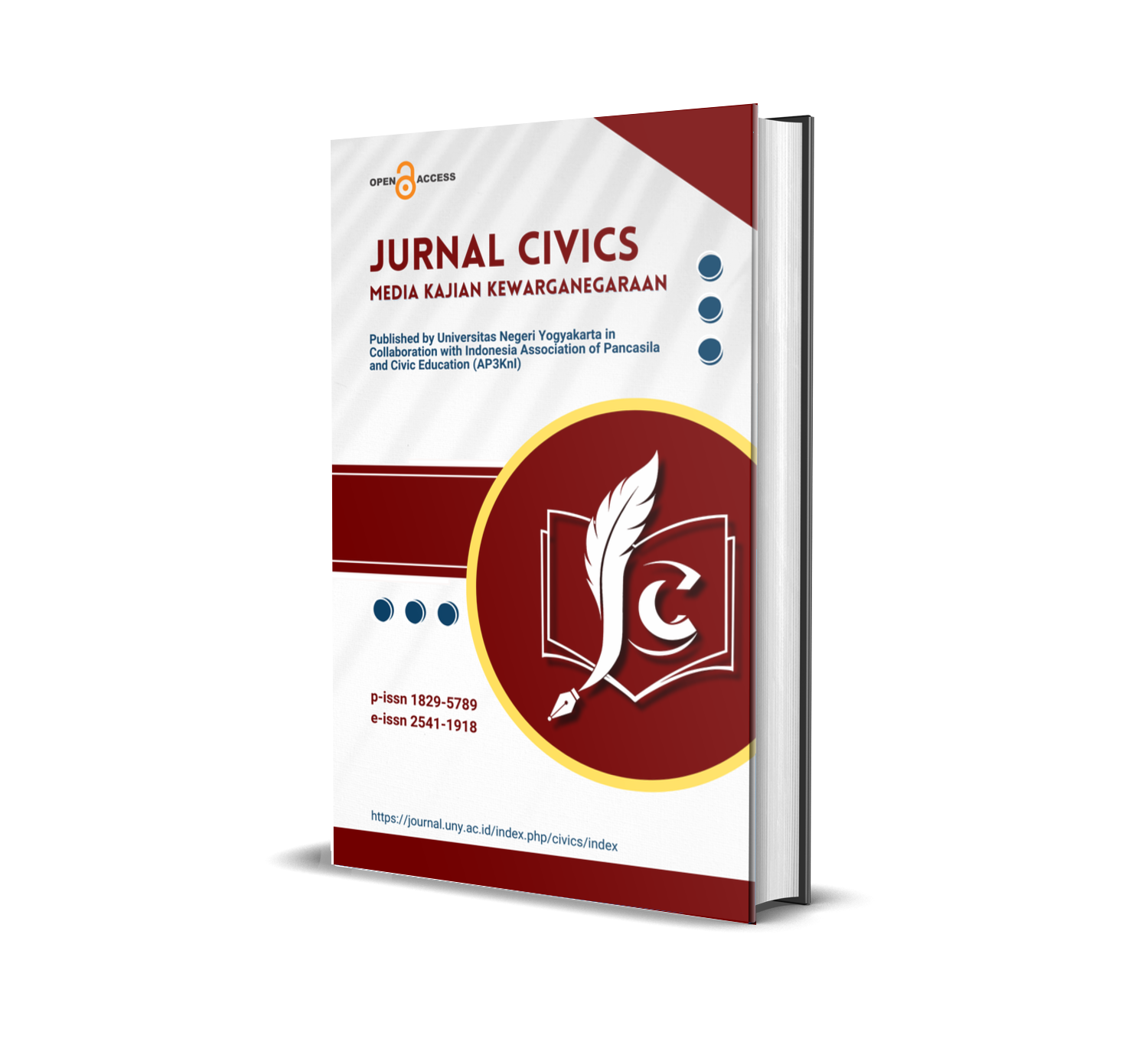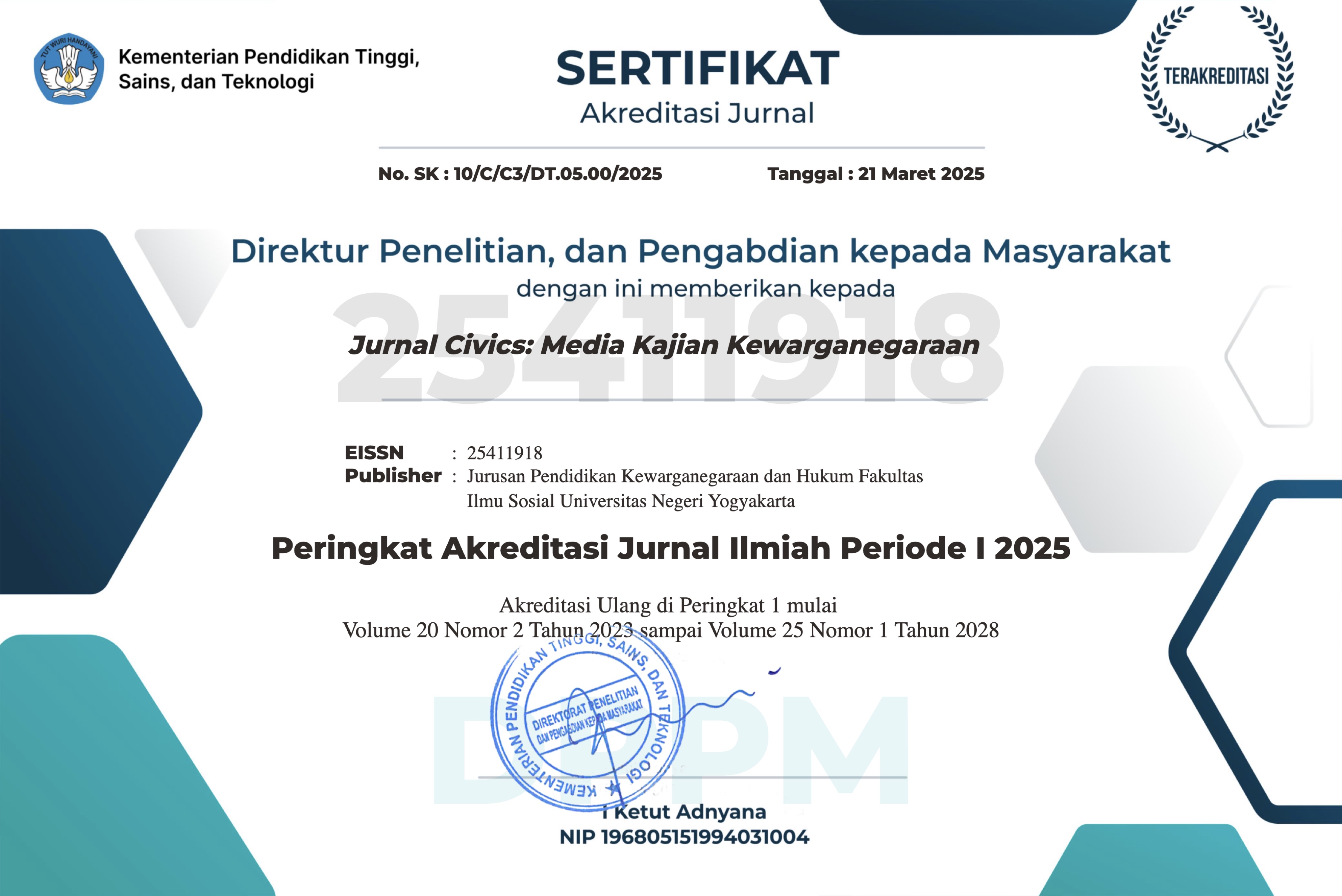Digital learning transformation in strengthening self-resilience
DOI:
https://doi.org/10.21831/jc.v18i1.36250Keywords:
transformation, digital-based learning, self-resilienceAbstract
The Covid-19 pandemic has forced teachers to conduct learning activities online through digital technology. As they are accustomed to the conventional or offline learning process, this digital-based learning transformation has resulted in teachers experiencing shock culture and students affected immensely. The current research aims to describe the strategies applied for digital-based learning, examine challenges in digital-based learning, and identify digital-based learning impacts on students' self-resilience. It employs the qualitative research method, and the data consist of primary and secondary data. The primary one is derived from the observation of focus group discussion and documentation. The secondary one is in the form of references from books, journals, and articles. By data reduction and conclusion drawing in a descriptive qualitative analysis, the findings show that using learning application varies depending on the teachers' capability and convenience, and agreement from the institution. The only learning media used in the format are videos and pictures, considering the weak internet bandwidth and limited internet quota. The challenges in digital-based learning should be the point of attention for both teachers and parents. The impacts resulted from this digital-based learning system on students' self-resilience are considerable. Supports from family and school must be wholly given to reinforce students' self-resilience.
References
Adams, E. (2013). Fundamentals of game design (3rd ed.). Pearson Education.
Andriani, T. (2016). Sistem pembelajaran berbasis teknologi informasi dan komunikasi. Sosial Budaya, 12(1), 117–126.
Antasari, I. W., & Novianti, W. (2019). Pemanfaatan grup WhatsApps pada komunitas Kelas Menulis Pustakawan (KMP). Medium: Jurnal Ilmiah Fakultas Ilmu Komunikasi, 7(1), 18–25.
Armawi, A. (2019). Nasionalisme dan dinamika ketahanan nasional. Gadjah Mada University Press.
Azis, T. N. (2019). Strategi pembelajaran era digital. The Annual Conference on Islamic Education and Social Science, 1(2), 308–318.
Danuri, M. (2019). Perkembangan dan transformasi teknologi digital. INFOKAM, 15(2), 116–123. http://amikjtc.com/jurnal/index.php/jurnal/article/view/178
Daryanto. (2012). Media pembelajaran. PT Sarana Tutorial Nurani Sejahtera.
Dorwal, P., Sachdev, R., Gautam, D., Jain, D., Sharma, P., Tiwari, A. K., & Raina, V. (2016). Role of WhatsApp messenger in the laboratory management system: A boon to communication. Journal of Medical Systems, 40(1), 1–5. https://doi.org/10.1007/s10916-015-0384-2
Efendi, N. M. (2018). Revolusi pembelajaran berbasis digital (Penggunaan animasi digital pada start up sebagai metode pembelajaran siswa belajar aktif). Habitus: Jurnal Pendidikan, Sosiologi, & Antropologi, 2(2), 173–182. https://doi.org/10.20961/habitus.v2i2.28788
Effendi, T. N. (2016). Budaya gotong royong masyarakat dalam perubahan sosial saat ini. Jurnal Pemikiran Sosiologi, 2(1), 1–18. https://doi.org/10.22146/jps.v2i1.23403
Enny. (2015). Effek samping penggunaan ponsel. Gema Teknologi, 17(4), 178–183. https://doi.org/10.14710/gt.v17i4.8938
Fatimah, F., & Kartikasari, R. D. (2018). Strategi belajar dan pembelajaran dalam meningkatkan keterampilan bahasa. Pena Literasi, 1(2), 124–137. https://doi.org/10.24853/pl.1.2.108-113
Fitzgerald, M., Kruschwitz, N., Bonnet, D., & Welch, M. (2013). Embracing digital technology: A new strategic imperative (Vol. 55, Issue 1). https://www.capgemini-consulting.com/SMR
Hasbullah, H., Juhji, J., & Maksum, A. (2019). Strategi belajar mengajar dalam upaya peningkatan hasil belajar pendidikan agama islam. EDURELIGIA: Jurnal Pendidikan Agama Islam, 3(1), 17–24. https://doi.org/10.33650/edureligia.v3i1.859
Hoyles, C., & Lagrange, J.-B. (Eds.). (2010). Mathematics education and technology-rethinking the terrain.
Idayati, R. (2011). Pengaruh radiasi handphone terhadap kesehatan. Jurnal Kedokteran Syiah Kuala, 11(2), 115–120.
Martono, N. (2014). Sosiologi perubahan sosial: Perspektif klasik, modern, posmodern, dan poskolonial. Raja Grafindo.
Masya, H., & Candra, D. A. (2016). Faktor-faktor yang mempengaruhi perilaku gangguan kecanduan game online pada peserta didik kelas X Di Madrasah Aliyah Al Furqon Prabumulih Tahun Pelajaran 2015/2016. KONSELI : Jurnal Bimbingan Dan Konseling, 3(2), 103–118. http://ejournal.radenintan.ac.id/index.php/konseli/article/view/575
Muhammad. (2011). Interaksi dalam keluarga. Gramedia Pustaka Utama.
Muhasim, M. (2017). Pengaruh tehnologi digital terhadap motivasi belajar peserta didik. PALAPA, 5(2), 53–77. https://doi.org/10.36088/palapa.v5i2.46
Muslih. (2016). Pemanfaatan media pembelajaran berbasis ICT pada lembaga pendidikan non-formal TPQ. Dimas: Jurnal Pemikiran Agama Untuk Pemberdayaan, 16(2), 215–234. https://doi.org/10.21580/dms.2016.162.1090
Ngafifi, M. (2014). Kemajuan teknologi dan pola hidup manusia dalam perspektif sosial budaya. Jurnal Pembangunan Pendidikan: Fondasi Dan Aplikasi, 2(1), 33–47. https://doi.org/10.21831/jppfa.v2i1.2616
Novrialdy, E. (2019). Online game addiction in adolescents: Impacts and its preventions. Buletin Psikologi, 27(2), 148. https://doi.org/10.22146/buletinpsikologi.47402
Rochmah, E. Y. (2016). Mengembangkan karakter tanggung jawab pada pembelajar (Perspektif psikologi barat dan psikologi Islam). AL-MURABBI : Jurnal Studi Kependidikan Dan Keislaman, 3(1), 36–54.
Rusman. (2012). Belajar dan pembelajaran berbasis komputer. Alfabeta.
Salam, M. (2020). WhatsApp: Kehadiran, aktivitas belajar, dan hasil belajar. Jurnal Pendidikan Matematika, 11(1), 89–98. https://doi.org/http://dx.doi.org/10.36709/jpm.v11i2.11675
Thomas, P. (2013). Faktor determinan produktivitas sekolah. Jurnal Penelitian Dan Evaluasi Pendidikan, 17(1), 55–71. https://doi.org/10.21831/pep.v17i1.1361
Utami, T. W., & Hodikoh, A. (2020). Kecanduan game online berhubungan dengan penyesuaian sosial pada remaja. Jurnal Keperawatan, 12(1), 17–22. https://doi.org/10.32583/KEPERAWATAN.V12I1.700
Wartana, M. H. (2011). Faktor-faktor yang mempengaruhi produktivitas kerja karyawan pada Como Shambala Estate at Begawan GiriUbud. Jurnal Perhotelan & Pariwisata, 1(1), 14–34.
Weseterman, G., Bonnet, D., & McAfee, A. (2014). The nine Elements of digital transformation. https://sloanreview.mit.edu/article/the-nine-elements-of-digital-transformation/
Zahroh, L. (2015). Pendekatan Dalam Pengelolaan Kelas. TASYRI’: JURNAL TARBIYAH-SYARI’AH ISLAMIYAH, 22(2), 175–189.
Downloads
Published
How to Cite
Issue
Section
Citation Check
License
The authors agree to transfer the transfer copyright of the article to The Jurnal Civics: Media Kajian Kewarganegaraan effective if and when the paper is accepted for publication.
Authors and other parties are bound to the Creative Commons Attribution-NonCommercial-ShareAlike 4.0 International License for the published articles, legal formal aspect of journal publication accessibility refers to Creative Commons Attribution-NonCommercial-ShareAlike 4.0 International License (CC BY-NC-SA).










